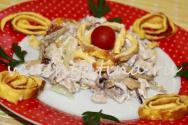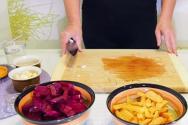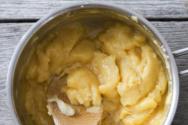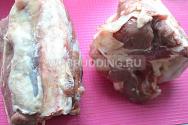French croissants step by step recipe. French classics: the secrets of perfect croissants. How to form croissants from dough
Simple bun croissant, which has become a cult dish, is no longer just food: croissants are both a lifestyle and an entire industry. These are the deliciously delicious stories of bakers who specialize in flaky bagels. And the culinary battles of housewives are at their most tender dough for croissants, the most delicious croissant filling and the most perfect croissant shape. How all this inspires you to get involved in the process!
Despite their French “registration”, croissants are actually “Austrian”: they were invented in Austria, and were first baked there too. There is an opinion that initially croissants, although tasty, were rather rough products, which were simply a piece rolled into a crescent yeast dough. Modern croissant with its airy lightness, literally permeated with taste and aroma butter, is unconditionally France in that special, culinary sense that is understandable to gourmets, while Austria is associated today with.
Croissant dough
A prerequisite for making croissants yourself is homemade. puff pastry. And this is the most difficult moment - some are afraid that the dough will not work out, others do not like to mess around, since it takes a lot of time. Yes, there are certain subtleties in working with puff pastry, owning which is the only way to get an amazingly delicious croissant, and not owning... Well, there are options here too: from a lifelong desire to cook French bagels to sporting anger: “I’ll make you anyway!!”
So, a croissant is a product made from puff pastry. Puff pastry for croissants is prepared in several steps, key point is cooling at each stage of kneading. This technology makes it possible to obtain solid, rather than tearing, layers of dough with butter coming out.
We will need only and exceptionally good butter with a fat content of 82%. Margarine won't work. The taste of a croissant directly depends on the taste of butter, of which there is a lot in the dough, and if you add margarine, then the taste will be “margarine”.
You can also add that puff pastry dough usually has fewer layers than unleavened dough. So, if in fresh dough before baking, about one and a half thousand layers are obtained, then in the yeast version - 24-72, depending on the desired thickness of the layers in the finished croissant.
Basic croissant recipe - no filling. At your discretion, you can add sweet or savory filling. The croissant can have a curved crescent shape or a straight one.
Cooking time: about 15 hours, taking into account the time for cooling the dough at each stage of preparation.
Exit: 16 small croissants or 8 large ones.

Ingredients
- butter 200 grams
- flour 2 cups + 2 tbsp. spoons
- milk 1 glass
- sugar 40 grams
- salt 1 heaped teaspoon
- dry fine yeast 7 grams
- egg for greasing products 1 pc.

Preparation
Big photos Small photos
Remove the butter from the refrigerator in advance so that it softens slightly.
Start preparing the yeast dough: mix 2 cups of flour and milk.

Mix the dough into a lumpy mass, cover with film and leave to autolyse for 20 minutes. This trick will help you knead a smooth dough faster and make it more elastic.

While the dough is going through the autolysis stage, rub the butter with 2 tbsp. spoons of flour.

From the resulting mass, form a layer measuring 12 by 8 and about 1 cm thick. This is convenient to do on cling film, in which you will then need to wrap the butter and put it in the refrigerator for 2-3 hours.

Now go back to the first dough and add salt, sugar and yeast to it.

Using a mixer fitted with the hook attachment, knead the dough.

Knead until smooth and very elastic.

Wrap the kneaded dough in a bag and place it in the refrigerator for 2 hours.
Then roll out the dough into a layer 8-10 mm thick and place a layer of chilled butter in the center.

Fold the top third first and then the bottom third, as if folding a piece of writing paper in thirds.

Using a gentle but firm beating motion with the rolling pin, flatten the buttered dough until it is about 1cm thick.

Now quickly and carefully roll the dough lightly with a rolling pin to even out the layer and fold it into thirds.

Place the dough in the refrigerator for 2-3 hours, covered with film.
Repeat the previous rolling process again, then refrigerate the dough again for 2 hours.
Then roll out the dough into a slightly thinner layer and fold it into quarters this time.

At this point the dough is ready to be shaped. If you cut it, you can see beautiful even layers.

So, cut the dough into 2 parts. Place one part in the refrigerator while you work on the other.
Roll out the dough into a long layer 12-14 cm high and 3-5 mm thick. First cut it into 4 squares and then cut each square diagonally.

Gently pulling with your hands, give the triangles a slightly elongated isosceles shape.

Roll the dough into a bagel shape. By the way, in this form you can freeze ready-made croissants and leave them for 7-8 hours before baking: during this time they will slowly defrost and grow.

Place the future croissants on a baking sheet lined with parchment and brush with beaten egg for the first time.

Leave the croissants to proof in the turned off oven for 3-3.5 hours. They will grow well there.

Now brush the croissants with egg again and bake them in an oven preheated to 210 degrees for 15 minutes.
Serve croissants hot or warm. The finished croissants can be cooled, wrapped in a bag and frozen, reheating in the microwave before serving. And don't forget to brew yourself a cup of coffee!


Cooking instructions
1 hour Print
1. Dissolve the yeast in 150 ml of warm water, let stand for 10 minutes, then stir. Crib How to prepare yeast
2. Sift the flour and pour into a deep bowl. Knead 30 g of butter with your hands and grind with flour. Add 1 egg, sugar, 0.5 teaspoons of salt, yeast and knead into a smooth elastic dough (knead for 10-15 minutes). Flour seeder tool Flour must be sifted even if you grind it yourself and guarantee the absence of lumps and pellets. Waking up through the sieve, the flour is loosened, saturated with oxygen, the dough rises better and then has a better texture. You can sift using any fine sieve or, for example, a special OXO seeder, which works on the principle of a meditative rocking chair.
3. Sprinkle the table with flour, roll out the dough into a rectangle measuring 50x20 cm. Mash the remaining butter and divide into 3 parts. Spread 1/3 of the butter onto 2/3 of the surface of the dough using the back of a tablespoon, leaving 2-3 cm from the edges of the dough (the butter should not completely melt, but consist of small lumps). Rolling pin tool To roll out a large sheet of dough, the rolling pin must be long. It will also be more convenient to perform a trick that allows you to make the thickness of the sheet uniform: hang the dough on a rolling pin and rotate it around it in the air. “Afisha-Eda” arranged a revision of rolling pins; the most maneuverable one turned out to be the beech one from the Bérard brand.
4. Fold the ungreased surface over half of the greased surface and cover with the remaining greased surface. You will get a three-layer rectangle measuring approximately 17x20 cm. Seal the edges of the dough well with your hands so that the butter does not come out when rolling out the dough further. Tool Silicone brush It is convenient to coat with hot glaze using a silicone brush - for example, Mario Batali. Silicone bristles do not stick together, and besides, silicone, unlike ordinary bristles, does not come out of the brush along with the glaze.
5. Turn the dough 90 degrees to the right and roll it out again into a rectangle measuring 50x20 cm. Carefully transfer the dough onto a sheet of parchment (or tracing paper), cover with a second sheet, fold in half, cover with a towel and put in the refrigerator for 30 minutes. After the specified time has passed, transfer the dough to a floured table.
6. Completely repeat the previous procedure 2 more times. Repeat the previous procedure 3 more times, but without oil. Place the dough in the refrigerator only after the third repetition.
7. Roll out the dough into a rectangle measuring 52x30 cm, cover with a towel and leave for 10 minutes. Then cut the dough in half lengthwise, cutting each layer into 8 triangles with a base of 13 cm.
8. Roll croissants out of triangles, place the tip down on a baking sheet greased with vegetable oil, giving them a crescent shape. The distance between croissants is at least 5 cm.
 Tool Baking paper
Open pies and quiches for even baking, it is better to place them in the oven on a wire rack, and to prevent the sauce boiling from the heat from dripping between the rods, baking paper will help. For example, the Finns produce a good one - it is quite dense and is already divided into sheets that are easy to get out of the box. And nothing more is required from paper.
Tool Baking paper
Open pies and quiches for even baking, it is better to place them in the oven on a wire rack, and to prevent the sauce boiling from the heat from dripping between the rods, baking paper will help. For example, the Finns produce a good one - it is quite dense and is already divided into sheets that are easy to get out of the box. And nothing more is required from paper.
9. Brush the croissants with egg and leave for 40 minutes to rise (preferably in a cupboard or cold oven so that there is no air flow, otherwise the croissants will dry out).
10. Preheat the oven to 220 degrees. Bake croissants for 15–20 minutes. Tool Oven thermometer How the oven actually heats up, even if you set a specific temperature, can only be understood with experience. It is better to have a small thermometer on hand that is placed in the oven or simply hung on the grill. And it is better that it shows degrees Celsius and Fahrenheit simultaneously and accurately - like a Swiss watch. A thermometer is important when you need to strictly observe the temperature regime: for example, in the case of baking.
Delicious homemade baking keeps the aromas of your home, the warmth of your beloved hands and an incomparable feeling of comfort. In order for it to turn out exactly like this, you need to put in a lot of work, patience and care. And it’s worth starting with the right test.
Creation of the dough

As is known, various pastries, whether it is a cake, cookies or croissants, requires an individual approach. The dough for each product is prepared according to a special recipe, observing many subtleties. In this regard, croissants, beloved by many, are one of the most capricious types of baked goods. They are made exclusively from puff pastry. It is its preparation that is the most labor-intensive step. To begin, wrap a piece of butter weighing 350 g in cling film sprinkled with flour, form a layer measuring 10 × 12 cm and put it in the refrigerator. Meanwhile, dilute 40 g of bar yeast in 200 ml of milk. Separately mix 500 g of sifted flour, 2 g of baking powder, 30 g each powdered sugar And vegetable oil, a pinch of salt. Then combine the yeast with the resulting mass and knead the dough.
Manual dexterity and endurance

Rolling out the dough requires special patience. We form a layer of dough measuring 12 × 20 cm, wrap it in film and put it in the refrigerator for 30 minutes. Then place the layer on a floured surface, place butter on one half of it, cover with the other half and pinch the edges. Carefully roll out the layer from the middle back and forth, strictly in one direction. The result should be a rectangle 1 cm thick. Visually divide it into three identical transverse parts and fold it into three layers. We wrap the layer with film again and put it first in the refrigerator for 15 minutes, and then in the freezer for 15 minutes. We repeat the procedure at least 5 times. At the same time, we roll out the dough perpendicular to the direction it was last time.
Secrets of the masters

To make croissants tender, tasty and crumbly, it is important to take into account several subtleties. French confectioners share their secrets of mastery. Butter should be chosen with a fat content of 82% or higher. Its volume should be approximately a third of the volume of flour. Even better is to take flour and butter in equal proportions. Give preference to “live” yeast and fresh flour from durum varieties wheat. Most importantly, the butter and dough should be the same consistency before rolling. It is recommended to knead croissant dough slowly, otherwise a large amount of oxygen can harm it. The ideal temperature for kneading is 15–16 °C. But proofing croissants requires a temperature of 25–26 °C.
Magic with a recipe
Agree, no matter how much we want to please our loved ones delicious pastries, time is sometimes sorely lacking. This is exactly what they came up with ready dough. But in our case it will be something special, namely a special dough for homemade croissants under the “Eat at Home” brand. This is a real rich puff pastry made from high-quality products according to all canons. It is made with the addition of a large amount of butter, which gives the croissants a tempting creamy flavor. In addition, the dough does not require additional rolling at all, which will significantly save your time and effort. In addition, the dough packaging has an unusual format. It is made in the form of a cookbook, on the back of which it is clearly stated step by step recipe making croissants.
Chocolate hit

Connoisseurs of French pastries know: real croissants are made without filling. However, this does not prevent gourmets around the world from choosing a wide variety of fillings for them. Croissants with chocolate are especially popular. So, cut the finished dough 3–5 mm thick into isosceles triangles with a base of 10 cm and sides of 20 cm. Grate a bar of dark chocolate and place a small amount on the base of the triangle. Roll the croissant and give it a crescent shape. We form the remaining triangles in the same way. Let the croissants rest for half an hour. Then we place them on a baking sheet with parchment, coat them with a mixture of yolk and milk with a brush. Bake the croissants in an oven preheated to 200°C for 20–25 minutes.
Homemade croissants prepared with care and love will be a wonderful treat for a family tea party. They will give your loved ones a feeling of a real holiday, which will warm you with warmth for a very long time.
I am writing the real ones because, out of curiosity, I looked for a recipe on google.ru, but all the recipes found in Russian do not match the original, either because of the proportions or because of the cooking technique.
For croissants and pan chocolate, yeast puff pastry is used.
Croissants and pan chocolate are a long process, but to be honest, they are worth it.
The convenient thing is that while the dough is proofing you can do something else. You won't believe the smell in the house. I think you should try it at least once.
I’m sharing the recipe, I hope it’s mine step by step description It will be useful for you to make your baking a success.
Start with half a portion: this makes it easier to roll out the dough, and when you get enough, move on to a whole portion (18 croissants or pan chocolate or 9 croissants + 9 pan chocolate).
Organization and timing
You can do everything on the same day, but I usually do all the steps before making the croissants on Saturday (steps 1 to 7 inclusive) and on Sunday morning I prepare the croissants and bake them (steps 8 to 10)
1. Kneading: 10-15 minutes
2. Proofing in a warm place at 30-35 degrees maximum: 30 minutes
3. First proofing in the refrigerator: 1 hour
4. The first phase of lamination of the dough: 15 - 20 minutes (at first it may be longer, but once you get the hang of it it will be 5 minutes)
5. Second proofing in the refrigerator: 30 minutes
6. Second phase of dough lamination: 15 minutes
7. Last (third) proofing in the refrigerator: 2 hours or better all night
8. Cooking croissants 15-20 minutes
9. Proof croissants in a warm place for 30 minutes
10. Baking croissants 15 minutes
2 important points:
1. Butter: at least 82% fat, preferably 84%
2. Flour premium and with a high % protein content in Italy it is called farina manitoba in France farine di gruau in other countries I don’t know, in France they also advise mixing T45 flour with T55 flour in half and half. But in my opinion, the best option remains Manitoba flour* with T45 flour (50% -50%)
Quantity of products for 18 croissants
500 grams of premium flour (if Manitoba flour is available*)
60 g granulated sugar
10 g salt
20 g fresh yeast
200 g lukewarm milk
60 g butter at room temperature
300 g butter 82% -84% fat,
1. Kneading the dough
I give 3 ways to knead the dough, depending on whether or not you have a mixer
With a kitchen aid type mixer or any other pastry mixer with a hook attachment
Using Worvek thermomics
By hand
Sift the flour into a large bowl (or the bowl of a mixer if making in a mixer). Gather it into a mound and make a depression in the center.
Mix salt and sugar in a large bowl on the side, so that when adding yeast there is no contact with either salt or sugar, as these 2 elements reduce the effect of yeast.
Crumble the yeast in a glass and dilute it with 200 grams of lukewarm milk. Gradually pour the yeast solution into the hole in the flour, mixing the dough (if in a mixer, then at low speed).
While kneading, add an egg and 60 grams of butter at room temperature to the dough. If you are making half a portion, beat the egg with a fork and whisk in 25 grams for the dough, and at the end you can brush the croissants with the remaining egg.
If you are making the dough in a kitchen mixer (Kitcheaid) with a hook, knead the dough for 8-10 minutes on medium speed (5 minutes for half a batch)
In the thermomix for 3-5 minutes if you make half a portion and up to 7 minutes if you make a whole portion.
If you do it by hand, then you need to knead the dough in a bowl in the beginning for 2-3 minutes, using your fingertips, until the oil is absorbed into the dough.
After this, place the dough on a clean table sprinkled with a little flour, take the dough in your hand and forcefully throw it on the table, then take it in the other hand and throw it on the table again, as if you wanted to hit it. And so on for 10-15 minutes.
This technique was used by all French bakers before machines appeared. The fact is that when classically kneading by hand, the dough heats up from contact with your hands and the yeast begins to ferment from the heat earlier than it should. At this stage we need to activate the gluten and not the yeast, so contact with hands is limited.
Continue beating the dough on the counter until it becomes smooth and elastic. You will feel with your hand how its consistency changes; it will become smoother and more tender.
Attention, regardless of whether you knead the dough by hand or in a machine, it is very important not to overwork it because if you knead it too long, it will become tough.
In order to check whether the dough is ready, you need to stretch it slightly with your fingers until it becomes thin to such an extent that it can be seen through, but it should not tear. If it breaks, you need to work on it some more. I check regularly so as not to overdo it.
2. Warm proofing
When the dough is ready, transfer it to a baking sheet lined with kitchen paper, cover with kitchen film and place in a warm place (25-30 degrees no more) to rise for 30 - 40 minutes. I put it in the oven, but since I have it at least 35 degrees, I leave it open.
3. First proofing in the refrigerator
When the volume of the dough has approximately doubled, press it lightly with your palm to release the air that was formed during the fermentation of the yeast.
Shape the dough into a rectangular shape, cover again with film and leave to proof in the refrigerator for about 45 - 60 minutes.
Now let's prepare the oil.
Place 300 grams of butter from the refrigerator in a plastic bag (or in kitchen film) and roll it out with a rolling pin, giving it the shape of a rectangle 1.5 - 2 centimeters thick.
Place the oil in film in the refrigerator. During subsequent layering, the dough and butter should be at the same temperature.
Let's start layering the dough
Place the dough on a floured table and roll out to a thickness of 1.5-2 centimeters, twice as long and slightly wider than the rolled out butter.
Place a rectangle of butter in the center of the dough and fold the dough over
Roll out to a thickness of 8 mm - 1 cm, all the time sprinkling flour on the table so that the dough does not stick, sweeping away excess flour with a brush before starting to roll.
The dough rectangle should be approximately 15 cm wide and 45 cm long, in any case the length should be 3 times greater than the width, and the thickness should be 6-8 millimeters.
If you feel that your dough is losing its elasticity from the heat or is starting to tear and the butter is escaping, put the rolled out layer in the refrigerator for 20 minutes and then continue rolling it.
You will see that with experience it will take you less and less time to layer.
Fold the bottom end of the dough for 2/3 of its length and the top for the remaining third, solder the seam (tap it lightly with a rolling pin) and then fold it in half (book) This is called a double layer.
Lightly smooth the dough with your palm to release air and tap the side and center seams lightly with a rolling pin to ensure they stick.
Wrap the dough in film and place it in the refrigerator for 30 minutes.
After half an hour, remove the dough from the refrigerator. Place it on the table as it lay before the refrigerator, turn the dough 90 degrees (the central seam should be on the right for you, if you are left-handed, then on the left) and roll it out into a layer 6-8 mm thick.
Sweep off the excess flour and fold the dough into thirds (with a wallet). This is called a simple layer.
Wrap the dough in film and put it in the refrigerator for at least an hour, I leave it overnight
Remove the dough from the refrigerator and roll it into a rectangular layer 8-6 mm thick. Trim the edges.
Cut the dough into triangles with a base of 12 cm and a height of 20 cm. Make a small cut of 1-2 cm in the middle of the base (6 cm), bend the triangle inward and put a small piece of dough cut from the edges into the middle. This piece will turn into an airy crumb when baked.
Starting from the wide end, roll the triangles into a bagel. Place on a baking sheet lined with baking paper and place in a warm place to proof (30 - 45 minutes depending on temperature.
I was somehow carried away by Switzerland (how can you not be carried away by it, right?) and completely forgot to tell about our meeting with pastry chef Laurent Boursier, quality director of the Volkonsky bakery chain.
Just a week before my trip, the Volkonsky cafe-bakery on Sretenka organized an incredible thing: Laurent Boursier himself personally shared with us the secrets of delicious croissants. Of course, anyone who has tried to make croissants themselves at least once in their life will understand that it is not enough to know the subtleties and secrets; a lot depends, of course, on experience. The perfect croissant is not easy. A real croissant is akin to art. And it turns out that this art was not invented by the French at all. Surely many of you are surprised now, right?
So, let’s ask questions and listen to the master. And at the end, we get the dough recipe from the maestro himself.
It was not the French who first produced the croissant; they did not invent it. But they brought it to perfection!
Then who? Who is the creator of this insanely airy, crispy, fragile, porous, melt-in-your-mouth work of art?
The main culprits of our... (sorry, I couldn’t resist, it just so happens that if we have something extra here and there, the croissant is to blame) are actually the Austrians. There are several official origin stories. But in both cases, the Austrians are to blame. One version says that even during the period of the Ottoman Empire, baking in the shape of a month was known; allegedly, during the siege of Vienna by the Turks, as a result, as a sign of victory, Austrian bakers baked a product in the shape of a crescent. This is the ancestor of the modern croissant. According to another version, the croissant came to France from Austria: a certain Monsieur Zang moved to live in Paris in the 19th century and opened his first bakery there, where they sold puff pastries, bagels and croissants prepared by his bakers using technology with the addition of sugar and butter to the dough. By the way, brioche, another symbol French cuisine, also originally from Austria. What new did the French bring? They began making croissants using yeast. The Austrians did not add them. A large amount of butter and yeast is what distinguishes a real croissant from its bagel ancestor.
Monsieur Laurent first cuts a bagel and then a croissant and uses examples to explain how they differ. And then he carefully unrolls the croissant into a ribbon. For what? Only the right croissant can open up like that, this is the pinnacle of skill!
Laurent also showed us a raspberry croissant, which uses raspberries, egg whites, almond cream and sugar for the filling - they say it’s very tasty, but I haven’t tried it yet. The authorship belongs to Laurent, and it seems that this croissant even appeared first in Volkonsky, and only then in France! That's how it happens;) Next year they promise something new, but so far they haven't given away the secret.
Breaking off the tip of a croissant, a member of the Academy of Culinary Arts of France, the National Academy of Culinary Arts, the international club White Cap, the Eurocap and Eurogastronomy Associations, and many other high-profile international associations (you can’t remember them all) recalled how he once “observed something terrible”: a visitor to “Volkonsky” I ate a croissant with a knife and fork. Who is this "savage"? All in all, it's even worse than drinking a cappuccino in Italy at lunchtime. God forbid you do this somewhere in Paris, but it’s okay, it’s not every day that Laurent walks around Volkonsky. Still, he is a busy man: he manages four dozen bakeries in Moscow, St. Petersburg, Nizhny and Kyiv.
Now we get to the secrets.
Are you listening? Are you recording? Are you ready to join the art?
1. Kneading. Oxygen in the dough is very important. But in this situation, the main thing is not to overdo it; you shouldn’t use a lot of oxygen. Knead thoroughly, but do not overdo it.
2. Sourdough, there should be a little yeast, the principle is that the dough should rise slowly.
3. It makes no difference what kind of yeast you use - dry or pressed. It's important that they work.
4. The ideal temperature for kneading dough is 24 degrees, for rolling out - 16, and for proofing - 25-26.
5. When rolling, it is important to change the direction of the dough (rotate 90 degrees). This will make it more plastic, it will be easier to give in to each subsequent rolling (you only need to fold the dough 3 times and put it in the cold).
6. At the stage of combining dough with oil, the ratio of dough to oil should be 250-300 g per 1 kg of dough.
7. The dough and butter should be close in consistency: if the dough is too dense and the butter is soft, it’s a disaster. If the dough is soft and the butter is dense, this is not a disaster, but it is also bad.
8. The oil should have at least 82.5% fat content (we simply haven’t seen higher fat content, although someone said that it happens), and ideally 84% or more.
9. The thickness of the dough at the time of cutting the triangles should be 2.5-3 mm. When folding, they need to be slightly stretched.
10. The longer the proofing process, the better the taste.

And, of course, I wouldn’t be a food blogger if I hadn’t asked for the dough recipe.
Strong flour 1000g
Biological yeast 30 - 40g
Salt 20g
Sugar 90-110g
Eggs (optional) 1 pc.
Milk or milk+water about 6 dl
Folding oil 450-600g
KNEADING
Weigh and sift the flour.
Add salt, sugar and almost all the milk or a mixture of milk and water (you should use a little less water if the dough will be rolled out on a dough sheeter).
Next, add yeast diluted in a small amount of water.
Knead the dough properly until it becomes elastic and elastic. The dough should easily come away from the sides of the container in which it is kneaded.
FIRST RISE OF THE DOUGH
Depending on the time of year, start making the first batch at room temperature for approximately 30 minutes.
Note: Cover the dough with a towel to prevent a crust from forming.
Then put the dough in the refrigerator (+5 ̊C) and leave it there until the next day.
If you want to use the dough the same day, leave it to rise for 1 hour, then place it in the refrigerator for a few minutes to make folding easier.
FOLDING
Roll out the dough into a rectangle approximately 1cm thick.
Spread the butter over half of the dough, rolled out into a rectangle.
Cover the half of the rectangle on which the butter lies with the other half. Align and “seal” the edges using a rolling pin.
Fold in three layers or in half twice.
SHAPING
After proofing for a few minutes, roll out the dough into a rectangle 32 cm long and approximately 3 mm thick.
Note: Sometimes it is necessary to cut the dough into two parts.
Cut the rectangle into two strips 16 cm wide.
Place one strip on top of the other, first sprinkling them with flour.
Cut triangles with a 12cm base, weighing approximately 40-50g.
Roll up the triangle, starting from the base, without pressing too hard. Work with both palms, stretching the dough slightly in opposite directions.
7. You can use a knife to cut the base of the triangle to make rolling easier.
Place crescent-shaped croissants on a dampened baking sheet: 20 on a 60x40 baking sheet. Try to place the croissants with the tips facing down.
Lightly coat the croissants with melange.
SECOND RISE OF DOUGH
Place the baking sheets in a proofing cabinet (35 - 40 °C).
Before the croissants finally rise, remove them from the proofing to give them the opportunity to “gain strength”.
Brush the croissants with melange again.
BAKERY
Set the oven temperature to 250 °C. Bake for approximately 12 minutes. Open the oven doors at the end of baking.
Wow! Serious work ahead!
Have you changed your mind about trying it?
I brought croissants home. I really like them with greens and Parma ham for lunch or late breakfast. It makes a nutritious and tasty snack.
They also treated us and told us a little about baguettes.







